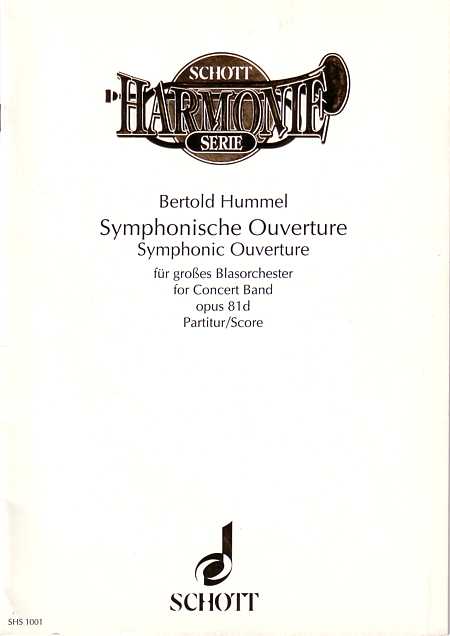Symphonic Ouverture for Concert band, opus 81d (1977)

Beginning
of the Symphonic Ouverture ![]()
Jugendblasorchester Werneck / Peter Blum
American first performance: November 22, 1987 in Seattle, Wash.
W.l.B.C. Directors Band / Bertold Hummel
Instrumentation:
1 Piccolo, 2 Flutes, 2 Oboes, 2 Bassoons, 1 E- Clarinet, 3 B- Clarinets, 1 B- Bass Ciarinet, 2 E- Alto Saxophones, 1 B- Tenor Saxophone, 1 E-
Baritone Saxophone,
3 B- Trumpets (Cornets), 4 Horns in F, 3 Trombones, 1 B- Baritone (Euphonium), 2 Basses, 1 String Bass, Timpani, Vibraphone,
Xylophone, Snare
Drum, Bongo
Drums, Bass
Drum, Wood
Block,
Temple Block, Ratchet, Tambourine, Triangle, 4 Suspended Cymbals, Pair of Cymbals, Gong,
Tam-tam, Bells
(optional)
Duration: 5 minutes
Publisher: Schott Music SHS 1001 / ISMN: 979-0-001-10066-3
Video: Works by Hummel on youtube
Bertold Hummel was
commissioned by an American conductors' association in
the state of Oregon to write a multi-movement piece.
The Symphonic Overture is part of this. A concise,
unaccompanied seven-note theme opens the overture.
This theme dominates the entire piece. It appears 52
times, transposed, sharpened with mixture sounds,
rhythmically broadened or shortened, mirrored, formed
into a crab, intensified tonally through sophisticated
instrumentation, condensed into a cluster, and finally
heightened to apotheosis through the layering of four
different forms of the theme. Bertold Hummel combines
traditional polyphonic composition techniques with
thematic work as developed in the Viennese Classical
period. In doing so, he finds his own individual
musical language. Several performances at the Federal
Music Festival by various orchestras prove that the
overture is suitable for amateur musicians. It
requires less technical virtuosity from the wind
players than an alert ear and sensitive response to
the sliding tempo changes.
Hans-Walter Berg
Press
Bayerische Blasmusik, December 1986
Here there was an impressive demonstration of what a varied treatment this instrument "Wind Orchestra" is capable, with which in future a broad spectrum of percussion instruments will be associated: the old combination wind / percussion presented in a completely new but very attractive way. Astonishing how the Werneck Youth Wind Orchestra under Peter Blum dealt with the high interpretational demands of this piece, which through its free use of intervals contrasting with traditional harmonic practice, its chamber music-like compositional development and its finesse in nuances of sound colour offers an entirely new terrain for the amateur musician, a new field in which the friend of wind music will find it worthwhile opening his mind and above all his ears.
Works for (amateur) wind orchestra
At the end of
this look at Bertold Hummel's symphonic work, some
remarks on his writing for amateur musicians is
necessary. In this field, he is very much in the
tradition of his teachers Genzmer and Hindemith, who
similarly never lost their rapport with the practices of
the non-professional musician. A natural maxim applies:
the simpler the concept, the more diatonic and
small-scale the building blocks and sounds. The aspect
of sound colour becomes less important and the
compositional characteristics are more strongly centred
on draughtsman-like linear structures with a
significantly conventional effect.
Of the symphonic works, those for wind orchestra are
among the simpler ones. Specifically conceived for
amateurs were the "Sinfonietta",
op. 39 (1970) and the "Musica
Urbana", op. 81c, composed in 1983 and baptised a
year later in Hummel's birthplace, Hüfingen, under his
direction with local musicians. At a slightly more
demanding level, Hummel composed in 1977 the "Oregon Symphony", op. 67,
performed for the first time on the 7th April, 1978 in
Ashland, Oregon (USA) in the presence of the composer.
Nine years later, during his second visit to the USA,
Hummel had the "Symphonic Overture", op. 81d (the
extended "Oregon Symphony") in his luggage and had this
performed for the first time in Seattle on the 21st
November, 1987 by the W.I.B.C Directors' Band.
Claus Kühnl (in "Die sinfonischen
Werke Bertold Hummels", Tutzing, 1998)